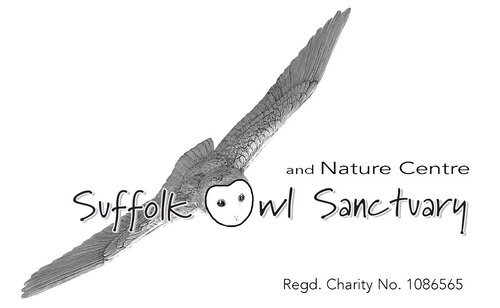There has been an air of eager anticipation here at the Sanctuary of late, with everyone waiting expectantly for not just one happy event, but a whole plethora! Currently, the falconers are hand-rearing two Eagle Owl chicks, one Asian Brown Wood Owl chick and two Lanner Falcon chicks. The Eagle Owl chicks are looking very plump and sturdy already and the Asian Brown, still tiny as yet, is being kept safe and warm in one of our brooders at a constant temperature between 25-26 degrees.
Down in the garden, something stirred.... one of the young Eagle Owl chicks enjoys some time in the sun
The arrival of this latter well & truly caught the attention of the media, and they were featured locally on the BBC and the Ipswich Star newspaper, as well as a story which ran in the Daily Telegraph - click here to see what they had to say.Meanwhile our Great Horned Owls, Huron and Pheonix, hatched two chicks last Monday and Wednesday respectively. Sadly one of these only survived for a couple of days as it was decidedly weak and could not be saved, but the other is in fine fettle. More successfully, the Booboks produced one youngster on Sunday the 26 April and as I write, one of the Southern Faced Scops Owls is also hatching.
A-Level Art
Amidst all this excitement we have already put our new pavilion to excellent use. The A-level art students from Northgate High School in Ipswich have taken part in a competition to create individual ‘owl’ posters. These are now all on display in the pavilion, along with voting slips for our visitors to nominate their favourite one. The winning design will be used to advertise the Sanctuary and the winning artist will receive a free owl adoption for one year. The cut off date for voting is the end of May bank holiday and we will let you know as soon as we have the results, as well as post all the designs here to our website.
Note from a Novice
As a newcomer to the world of raptors and falconry, I am just beginning to touch on some of the vast extent of knowledge and skill entailed in looking after birds of prey. To date I have: discovered how to prepare raptor delicacies (rather a messy process involving the removal of various internal bits from rats & mice, which I won’t elaborate on); held an owl on a falconry glove (just a small one) and wondered why my arm nearly fell off the next day and learnt how to tie a falconer’s knot, courtesy of Dean who actually made this incomprehensible tangle of rope remarkably straightforward.
For a person who is passionate about all wildlife, I have to admit to knowing very little about raptors. What has amazed me over the last few months as I have been writing this blog is the realization that each bird of prey has its own distinctive personality. Suddenly they’re not just birds but unique characters – wonderful!
Fascinating Raptor Facts
On Friday last, I had the real privilege of watching one of the amazing aerial displays that take place here twice a day from April through to September. Apart from being a stunning way to see various raptors take to the skies in all their full glory, I was impressed by how much information it was possible to glean from one demonstration.
This action shot of Mir, the Steppe Eagle, by our friend Brian Macfarlane shows off the
immense size & strength of the wings that transport the species over the Himalayas from Russia to Africa and back every year....
The first bird in the demonstration was Mir the Steppe Eagle, who is fourteen years old. On the steppes of her native Russia, with a bit of luck she would live until she was about 25, but here at the Sanctuary there is a good chance she will continue on well into her forties! Life in the wild is tough for a Steppe Eagle as they have to undertake the longest migration of any Eagle species - all the way from Russia to Africa.
Not only is this a tremendous distance, but also involves some drastic changes in situation for the Steppe Eagle. For example, in Russia Mir would be pretty much the top predator, with marmots being her cuisine of choice. Once in Africa however, she would suddenly be right down in the pecking order near to the bottom of the food chain. As if that weren’t bad enough, in Africa there are no marmots either. However there are plenty of other things she would eat such as lizards and her favourite African delicacy would be – you’d never guess –termites! Given that Mir weighs a stately 6 ½ pounds and has a wing span of around 6 feet, you might think that a diet of termites would leave her feeling rather peckish. Well, as long as a Steppe Eagle can devour around 2 to 2 ½ thousand termites then apparently that’s no problem!
So that was Mir. I also learnt a whole host of fascinating facts about Cobweb the Barn Owl, Nell the Saker Falcon, Bali the Asian Brown Wood Owl and Gypsy the American Black Vulture – but space eludes me. Be sure to log on for next week’s instalment! Better still, come to the Sanctuary and see these amazing birds for yourself.















































